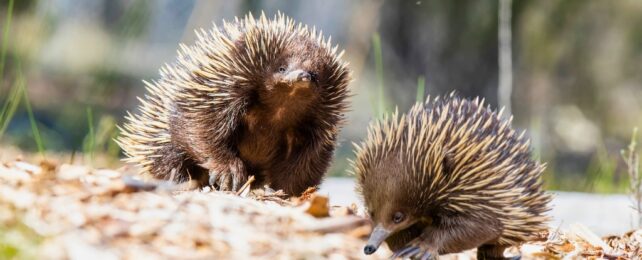Researchers have captured recordings of echidnas cooing, grunting, and making other sounds. But there's a twist: they only do it during the breeding season.
This discovery provides firm evidence that these spiky critters from Australia who eat termites and lay eggs are capable of vocalizing, which has been a topic of debate among scientists for years.
Wild short-beaked echidnas (Tachyglossus aculeatus) at Dryandra National Park in Western Australia cooed, grunted, wheezed, and exhaled – and a team from Curtin University in Australia, along with colleagues from the UK, recorded them.
"As far as we are aware vocalization by echidnas has not been documented in the published literature," the researchers write in their published paper.
"Auditory communication was long considered absent for echidnas, with their only recognized sounds being 'sniffing' noises."
Adult echidnas made the sounds when they were solo or hanging out with a fellow echidna. All the recorded vocalizations were made during the breeding season, so it appears to be something they reserve for special occasions.
"Our team managed to capture some of these sounds with hand-held microphones as well as a camera and microphone left unattended at the entrance to a cave popular with echidnas," explains vertebrate ecophysiologist Christine Cooper, from Curtin University.
"Careful analysis of those cooing and grunting sounds showed echidnas are capable of vocalizing, aligning them with most other mammals in their use of acoustic communication."
Acoustic communication is part of life for many terrestrial vertebrates. It evolved independently in different groups of animals, including mammals, birds, geckos, crocodilians, and frogs.
The sounds they produce can be used to attract mates, defend or attack, exchange information, keep in touch, or even communicate with other animals, including humans.
The echidna sound recordings and the fact that the platypus, another monotreme (egg-laying mammal) also makes sounds, help resolve scientific dispute about when early mammals started making sounds to communicate.
"If both monotremes and other mammals vocalize, this suggests that the common ancestor of these two evolutionary lineages could also vocalize," says Cooper.
There's no debate around whether the ancestors of therian mammals used acoustic communication. Therian mammals are those who give birth to live young, including placental mammals like us and marsupials, who usually like to store their babies in a pouch.
But it's not clear if the reconstruction of the root of the mammalian sound tree should include the ancestors of monotremes.
"While other forms of communication, such as vibrational and chemical signals, are known to have appeared much earlier," Cooper adds, "our findings confirm that acoustic communication using sound likely developed 100 to 200 million years ago and before monotremes diverged from other mammals."
Echidnas are among the cutest, weirdest critters around, and some of their features seem difficult to believe.
Science has shown us more about their behavior recently, and these findings suggest we still have a lot to learn about these unique Aussie characters.
"So, although we don't know the purpose or understand the meaning of the short-beaked echidna's grunting and cooing," Cooper concludes, "we have only heard them from adult animals during the breeding season, suggesting echidnas only find their voice when reproductively active."
The study has been published in the Journal of Zoology.
